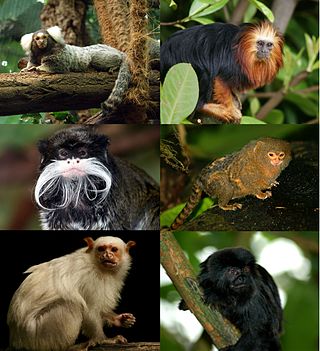
The Callitrichidae are a family of New World monkeys, including marmosets, tamarins, and lion tamarins. At times, this group of animals has been regarded as a subfamily, called the Callitrichinae, of the family Cebidae.

The pied tamarin, sometimes referred to as the Brazilian bare-faced tamarin, is a critically endangered species of primate found in a restricted area of the Brazilian Amazon Rainforest. It was named the mascot of Manaus, Brazil in 2005. The species is endangered due to the increasing size of the city of Manaus which is encroaching on their native habitat.
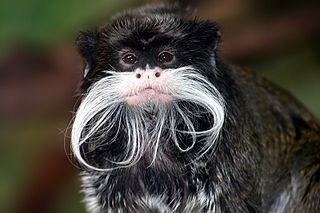
The tamarins are squirrel-sized New World monkeys from the family Callitrichidae in the genus Saguinus. They are the first offshoot in the Callitrichidae tree, and therefore are the sister group of a clade formed by the lion tamarins, Goeldi's monkeys and marmosets.

The cotton-top tamarin is a small New World monkey weighing less than 0.5 kg (1.1 lb). This New World monkey can live up to 24 years, but most of them die by 13 years. One of the smallest primates, the cotton-top tamarin is easily recognized by the long, white sagittal crest extending from its forehead to its shoulders. The species is found in tropical forest edges and secondary forests in northwestern Colombia, where it is arboreal and diurnal. Its diet includes insects and plant exudates, and it is an important seed disperser in the tropical ecosystem.

The white-lipped tamarin, also known as the red-bellied tamarin, is a tamarin which lives in the Amazon area of Brazil and Bolivia.

The emperor tamarin is a species of tamarin monkey allegedly named for its resemblance to the German emperor Wilhelm II. It lives in the north Brazilian states of Acre and Amazonas and the southwest Amazon Basin, in east Peru, north Bolivia.

The golden-handed tamarin, also known as the red-handed tamarin or Midas tamarin, is a New World monkey belonging to the family Callitrichidae.

Martins's tamarin or Martin's ochraceous bare-face tamarin, is a species of tamarin endemic to Brazil.

The black-mantled tamarin, Leontocebus nigricollis, is a species of saddle-back tamarin from the northwestern Amazon in far western Brazil, southeastern Colombia, north-eastern Peru and eastern Ecuador.

The black tamarin or western black-handed tamarin is a species of tamarin endemic to Brazil.

The moustached tamarin is a New World monkey and a species of tamarin. The moustached tamarin is named for the lack of coloring in the facial hair surrounding their mouth, appearing similar to a moustache. As with all New World monkeys, the moustached tamarin is found only in areas of Central and South America.

The brown-mantled tamarin, also known as Spix's saddle-back tamarin, is a species of saddle-back tamarin. This New World monkey is found in the Southern American countries of Bolivia, Brazil and Peru. This omnivorous member of the Callitrichidae family is usually found in smaller groups ranging between 4 and 15 individuals. This species communicates vocally and largely rely their olfactory system. The brown-mantled tamarin is considered as a species of Least Concern by the International Union for Conservation of Nature, despite a decreasing population and being threatened by poaching, habitat loss and capture for the illegal pet trade.

The white-footed tamarin is a tamarin species endemic to Colombia. It is a silvery brown colour with pale streaks and russet underparts, and is very similar in appearance to the cotton-top tamarin, from which it is separated by the Atrato River. It is thought that the two species diverged during the Pleistocene, at a time when a sea occupied the area between their present ranges. This tamarin is an arboreal species, living in small family groups in the canopy. Females give birth to one to three young after a gestation period of about 140 days. This species has a relatively small range and is under threat from destruction and fragmentation of the forest in which it lives and the International Union for Conservation of Nature has assessed its conservation status as "vulnerable".

The black-chinned emperor tamarin is one of the two subspecies of the emperor tamarin. Unlike the bearded emperor tamarin, it has no beard. It is distributed throughout the rainforests of Brazil, Peru, and Bolivia. Not much on its conservation is known, so it is listed as Data Deficient by the IUCN. After a gestation period of 140–145 days, females usually give birth to one or two young. It is the same size as the emperor tamarin and it eats almost the same food: bugs, spiders, fruit, tree sap, and nectar.

The bearded emperor tamarin is one of the two subspecies of the emperor tamarin. It is mostly found in the tropical forests of southwestern Brazil and eastern Peru. This omnivorous member of the Callitrichidae family is usually found in groups of 4 and shares social relations with other callitrichids. They communicate vocally, as well as with olfactory signals. Males tend to be primary caregivers for their young. It is considered as a species of Least Concern by the IUCN, despite threats from increased habitat loss.
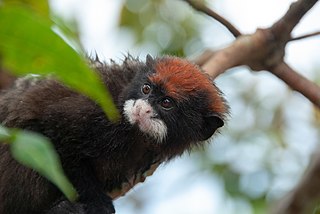
The red-capped tamarin, is subspecies of moustached tamarin from South America. They are found in Brazil, on the eastern margin of the Tefé and Coari rivers. Previously recognised as a separate species, Saguinus pilatus, the red-capped tamarin was demoted to subspecies status by a taxonomic review by Rylands et al., (2016).
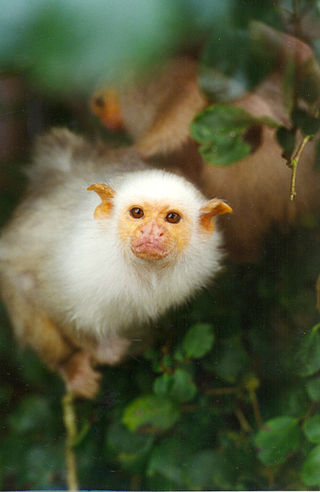
Mico is a genus of New World monkeys of the family Callitrichidae, the family containing marmosets and tamarins. The genus was formerly considered a subgenus of the genus Callithrix.
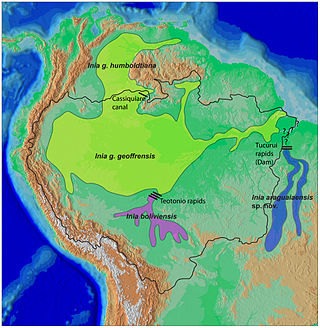
The Araguaian river dolphin or Araguaian boto is a South American river dolphin population native to the Araguaia–Tocantins basin of Brazil.

The Xingu–Tocantins–Araguaia moist forests (NT0180) is an ecoregion in the eastern Amazon basin. It is part of the Amazon biome. The ecoregion is one of the most severely degraded of the Amazon region, suffering from large-scale deforestation and selective extraction of timber, particularly along the Trans-Amazonian Highway and in the higher and more populated southern portions.

The Tocantins–Araguaia–Maranhão moist forests (NT0170), also called the Tocantins/Pindaré moist forests, is an ecoregion in the north of Brazil to the south of the mouth of the Amazon River. It is part of the Amazon biome. The ecoregion contains the city of Belém, capital of the state of Pará. It is the most developed part of the Amazon region, and is one of the most severely degraded natural habitats of the region.




















